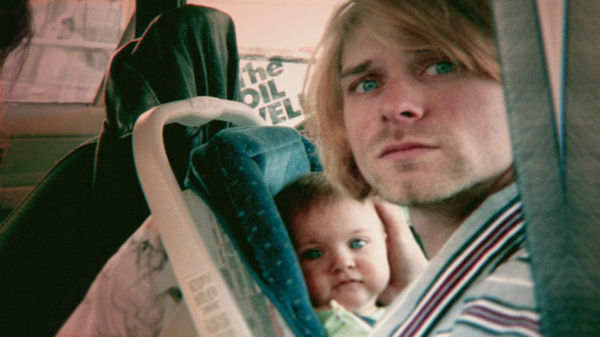Movie review by Greg Carlson
Veteran documentary filmmaker Brett Morgen’s years of hard work pay off in “Kurt Cobain: Montage of Heck,” a stunning biographical portrait of the artist and musician. Morgen’s film, made with the full cooperation of Cobain’s survivors, includes Frances Bean Cobain as an executive producer. The director’s “all access pass” to the comprehensive Cobain archive brands his movie as the closest thing to a definitive treatment, and the arresting animation that illustrates a huge amount of the film’s content both visualizes audio-only elements and brings Cobain’s artwork to vivid life.
For devoted Nirvana fanatics, “Montage of Heck” covers some familiar territory, including the grim “be careful what you wish for” narrative that sees the band catapult to stratospheric success seemingly overnight. Fortunately, however, Morgen shrewdly, carefully, and emphatically applies an ever-present sense of clear-eyed skepticism that challenges many of the most durable and dogged myths surrounding Cobain. Additionally, the moviemaker deliberately lets the music speak for itself, skipping analysis and discussion of practically the entirety of Nirvana’s aural/recording history.
Instead, those songs – scorching, ragged, acidic, narcotic, haunting, and haunted – provide a full soundtrack to an intimate exploration of Cobain without tripping over or succumbing to the undesirable “voice of a generation” mantle. For the most part, Morgen trades the icon for the human being, limiting the number of talking heads to only seven new on-camera interviewees, including mother Wendy, whose narration fills out the riveting opening chapters of the film. Krist Novoselic is one of the seven, but Dave Grohl is not (according to Morgen, Grohl’s interviews were collected too late to make the cut).
Cobain’s own voice is thoroughly present, taken from both public and private recordings. The marked separation between the disdainful, unconcealed contempt for MTV – or “empty TV” as Cobain tags it – and the naked, personal cassette confessions coil like snakes on the caduceus. In one of the movie’s most affecting sequences, Cobain shares the traumatic tale of an attempt to lose his virginity. The sad story is animated by Hisko Hulsing (whose “Junkyard,” among its many accolades, received the top prize in animation at the 2013 Fargo Film Festival). Hulsing’s painterly style contrasts with the equally valuable contributions of Stefan Nadelman, who animated the textual and graphic content from Cobain’s notebooks.
AJ Schnack’s beautiful, impressionistic “Kurt Cobain: About a Son,” serene in comparison to the rapid-fire collage of “Montage of Heck,” relied on audio interviews between Cobain and Michael Azerrad, and Morgen makes use of the similarly insightful responses given by Cobain to David Fricke, probably the finest journalist to write about Nirvana. Cobain’s self-reflection and introspection on Fricke’s tapes stretch toward a kind of peace that looks a million miles away in the movie’s toughest, most distressing scene: a ghostly, ravaged Cobain nodding out while he holds Frances during her first haircut.
Cobain’s legendary sensitivity emerges as one of the film’s principal themes, particularly in the way that the singer’s fear of humiliation informed everything from how the band was presented to Kurt’s desperate desire to build the loving and nurturing families denied to him by the divorce of his parents and the painful rejection that devastated him throughout his teens. Without question, Kurt Cobain would not have wanted any of these personal moments served up for public consumption, but in his absence, Morgen makes a strong case for sharing this particular story of an unforgettable subject.
